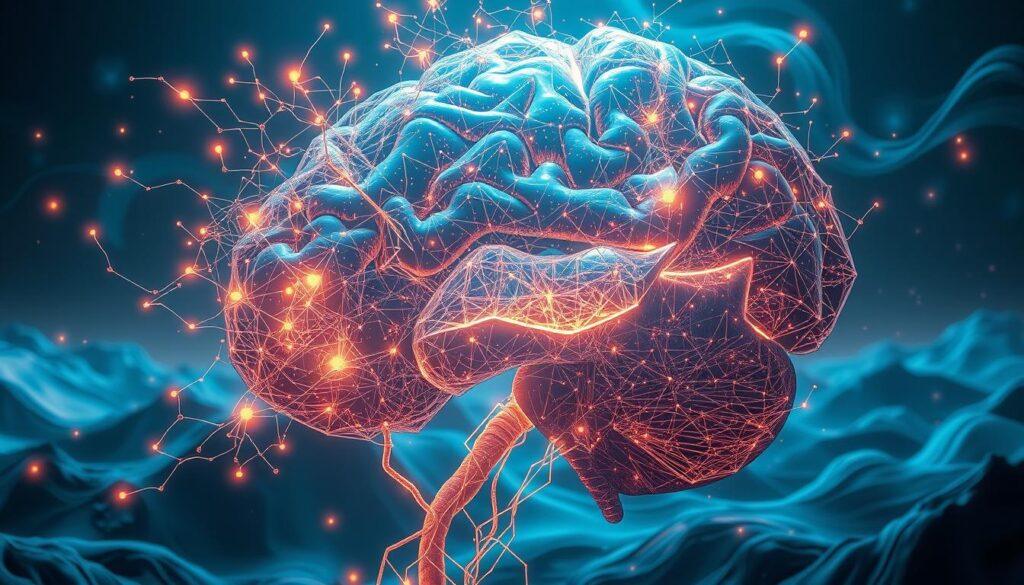Ever wondered why kids pick up grammar faster than top AI? The language instinct mental model has a surprising answer. It says your brain is ready to learn language from the start.
This idea, introduced by psychologist Steven Pinker in 1994, in his book The Language Instinct, shakes up the view that language is just a social skill.
Instead, it suggests that grammar rules are like a built-in mental tool. This tool shapes how you speak and think.
Key Takeaways
- Language isn’t just learned—it’s part of human biology, per Pinker’s research.
- Every human society shares core grammar rules, proving universal linguistic principles.
- Children build complex sentences by age two, outperforming AI despite zero formal training.
- Neurological studies show language operates separately from other brain functions, like math or memory.
- Cognitive linguistics explores how this innate system interacts with culture and environment.
This model connects psychology, neuroscience, and anthropology. It shows how your brain’s language tools influence your first words and understanding of metaphors.
This article explores the science behind why you can’t stop talking, even when robots can’t.
Understanding the Language Instinct Mental Model
The language instinct mental model is a debate about how we learn to talk. It suggests that language is not just learned, but also comes from our biology. Let’s dive into how this idea came to be and why it’s important.
Origins of the Language Instinct Theory
Noam Chomsky started the idea of universal grammar. He said all humans have a built-in way of understanding language. His work led to the language instinct mental model, which looks at how evolution helps us learn grammar naturally.
Steven Pinker’s Contribution to Linguistic Theory
In 1994, Pinker wrote The Language Instinct. He said learning language is as natural as walking. He argued that kids don’t need to be taught to speak, unlike what some thought.
The book shows how kids, even in tough environments, create their own grammar. Pinker used science and everyday examples in his 483-page book. His ISBN 0-688-12141-1 edition is a key work in the field.
Pinker compares language’s critical learning window to a kitten’s vision development—miss it, and skills falter forever.
Key Principles Behind the Mental Model
This model is based on three main ideas: universal grammar, brain modules for language, and innate learning triggers. Even deaf babies make signs, showing they have an innate ability to communicate.
Pinker also points out how brain damage, like Broca’s aphasia, shows language is made up of modules. This explains why kids pick up grammar quickly, even without formal lessons.
The Science Behind Our Natural Language Abilities
Imagine a child in a bustling market, surrounded by broken phrases of a trade pidgin. Within a generation, they invent a full-fledged creole language with consistent grammar. This isn’t fiction—it’s documented in studies Steven Pinker cites, like those of Derek Bickerton.
Innate language skills drive this transformation, showing how humans naturally organize chaos into structure. Even deaf children, isolated from spoken language, create sign systems with syntax and rules, proving language isn’t just learned—it’s built into our brains. 
Language processing begins long before words form. Infants as young as 6 months distinguish 600 global consonants, but by 12 months focus on their native tongue’s 40 sounds. Brain scans via Magnetoencephalography (MEG) reveal neural networks firing uniquely during speech, proving language isn’t just a social tool—it’s hardwired. P
inker’s work, as reviewed in scientific analyses, compares language to spiders spinning webs: instinct guides the foundation, but environment shapes the design.
Consider this: children raised in silence never speak fluently, yet those in noisy markets speak with grammar. This contrast highlights how innate language skills form a baseline, while culture molds expression.
Modern neuroscience shows babies’ brains prioritize speech sounds over other noises, a sign of evolutionary adaptation. Whether signing, speaking, or inventing creoles, our minds are wired to connect through language—proving words are as natural as breathing.
How the Language Instinct Shapes Human Development
Every time you speak, you’re using a skill shaped by millions of years of evolution. Language acquisition starts before birth, with infants responding to speech rhythms. By age two, most children master grammar rules their parents never taught them.
This innate wiring interacts with environment to build language development pathways unique to each individual.
“Deaf infants ‘babble’ with their hands, proving language instinct exists beyond spoken words.”
| Study | Year | Key Finding | Relevance |
|---|---|---|---|
| Kuhl et al. (2003) | 2003 | Face-to-face interaction accelerates phonetic learning | Showcases environmental amplification of innate skills |
| Petitto & Marentette (1991) | 1991 | Sign language babbling in deaf infants | Proves innate capacity across modalities |
| van der Lely (2005) | 2005 | 7% of children struggle with grammar despite normal IQ | Highlights innate language modules’ role |
Language Acquisition in Children
Watch a toddler invent new sentences you’ve never heard, and you’re witnessing evolution in action. When isolated groups of children create creole languages from pidgin, they invent consistent grammar rules without instruction.
This mirrors how deaf children in Nicaragua spontaneously developed a sign language in the 1980s—a natural experiment proving language acquisition is hardwired.
Neuroscientists note brain regions like Broca’s area specialize in syntax, while damage here causes aphasia, proving language isn’t just general intelligence.
Critical Periods for Language Learning
Miss the window of childhood language development and your brain reorganizes. Like kittens needing visual stimuli to see, children after age 7 struggle to master accents. Brain scans show neural pathways for grammar form most efficiently before puberty, then prune unused language circuits to focus on other skills like math or music.
Universal Grammar Across Cultures
Noam Chomsky’s universal grammar theory explains why all languages distinguish nouns from verbs—even in invented creoles. This mental framework lets children in Tokyo and Toronto grasp sentence structures faster than robots.
AI can’t match a 3-year old’s grasp of “over” versus “under,” proving our minds are prewired for linguistic patterns.
The Role of Environment vs. Innate Skills
Your upbringing influences how you use your innate toolkit. A bilingual family shapes vocabulary choices, but the core grammar engine runs the same in every brain. Nature provides the engine; nurture determines which roads you drive it on.
Even isolated Amazon tribes develop complex verb systems, proving the blueprint exists before culture.
Language and the Brain: Neurological Foundations
Every word you speak or read sparks complex brain activity. Scientists have found key areas like Broca’s and Wernicke’s, which handle speech. Damage here leads to specific language problems, showing language needs special brain paths.
Our brains are flexible and change with language use. By 10 months, babies start babbling in patterns of their native language. Brain scans show that by age one, they have the basics of sound patterns.
Between 18–36 months, their brain’s syntax grows. And by 18 months, their vocabulary explodes. This is when their brain is wired for linguistic cognition non-stop.
Studies show babies can tell different language sounds before they can speak. For example, Japanese babies learn to tell r/l sounds, while Spanish babies focus on b/p. This is a critical time, before they are one year old, as research on neural commitment shows. By eight, they can make all sounds of their native language.
Our brain systems aren’t fixed. fMRI scans show adults can change brain activity when learning new languages. But, syntax and grammar are most flexible in childhood. Every time you speak, you’re using a blueprint shaped by evolution. Your brain was made for language, not the other way around.
Practical Applications of the Language Instinct Model
Imagine learning a new language without endless grammar drills. Neuro-linguistic programming uses your brain’s natural language skills. This makes learning feel natural and easy.
Teachers use this idea to create learning plans that feel like how kids learn. For example, they use immersion methods. These methods help kids learn word order and tense rules naturally.

“Language is a biological adaptation like the spine,” explains Steven Pinker, whose theories underpin modern language rehab practices. Therapists treating aphasia use these principles to retrain neural pathways , leveraging the brain’s innate language processing mechanisms.
AI developers also use this model. Voice assistants and translation tools now use grammatical pattern recognition. This is inspired by Pinker’s work on how we naturally understand language.
Even though some argue against it, the model is changing tech. It powers speech recognition software and chatbots.
| Application | Traditional Approach | Instinct-Based Approach |
|---|---|---|
| Language Teaching | Rote memorization | Contextual immersion |
| Speech Therapy | Rule-based exercises | Neural pathway stimulation |
| AI Development | Keyword matching | Syntactic pattern analysis |
When learning a second language, try to mimic native speakers. Your brain’s natural language processing skills will take over. The debate on the “language instinct” theory goes on, but its effects in education, healthcare, and tech are clear.
Try these strategies to unlock your natural language skills today.
Common Misconceptions About Language Acquisition
Think mastering a language is a battle? Let science set the record straight. Cognitive linguistics shows how your brain naturally handles language better than myths say. Here’s the truth behind three widespread fallacies.
The Myth of Language Learning Difficulty
Many think language learning needs endless drills. But research shows kids learn grammar without explicit lessons. A 2015 critique by Vyvyan Evans challenges Noam Chomsky’s “Universal Grammar” theory.
It argues social interaction, not just innate rules, shapes language. Even adults can learn fast: a Polish boy in one study mastered basic English phrases in 45 days. This proves brains adapt faster than myths suggest.
Debunking Multilingualism Myths
Believe raising kids bilingual causes confusion? Studies show the opposite. Adoptedees in a 2002 study gained 68 English words by 22 months, outpacing peers in monolingual settings.
Multilingualism sharpens cognitive flexibility, not clouds it. Cognitive linguistics confirms early exposure builds stronger neural pathways for any language, not just one.
The Truth About “Language Genes”
Genes like FOXP2 get called “language genes,” but that’s an oversimplification. The KE family’s mutation affected speech mechanics, not just grammar, showing language involves more than biology.
While genetics matter, cognitive linguistics emphasizes that practice—not DNA alone—drives fluency. Even with genetic predispositions, environment and effort remain key.
How You Can Leverage Your Natural Language Abilities
Imagine unlocking your full language skills. By using neuro-linguistic programming and understanding language development, you can change how you learn and talk. Start by using your brain’s tools. As language theorists like Steven Pinker say, your mind has a universal grammar. This makes learning new languages easier.
Practical Techniques Based on Linguistic Theory
Start by immersing yourself in the language you want to learn. Watch media, listen to podcasts, or talk to people. Your brain picks up patterns easily, so keep at it to get better. Repeat phrases out loud to help your brain remember them.
Studies show speaking out loud helps you remember things 40% better than reading silently.
Optimizing Your Approach to New Languages
Learn the basic grammar rules first. For example, learning Spanish verb conjugations is like how kids learn tense systems early on. Use flashcards to help you remember words and their meanings. Focus on common words, as they make up 80% of daily talks.
Using Neuro-Linguistic Programming Principles
Use visualization to connect words with images. For example, link “bonjour” with a sunny café scene to remember it better. Neuro-linguistic programming also suggests mirroring native speakers. This helps you pick up their rhythm and tone.
Try telling stories out loud to improve listening and speaking at the same time.
Your brain is ready to learn languages. By working with it, you can overcome any obstacle. Start with short, daily practice sessions. Celebrate your small wins. Your natural language skills will guide you.
Conclusion: Embracing Your Innate Language Capacity
Innate language skills are deeply rooted in our biology. They shape how we absorb and use language from infancy. By age 3, most children speak in full sentences. By 5, 90% have mastered their first language.
This natural ability isn’t just about grammar. It’s the foundation for storytelling, problem-solving, and social connection. Imagine the possibilities when you trust your brain’s built-in linguistic machinery.
Recent debates challenge traditional views like Noam Chomsky’s Universal Grammar. Research highlights the role of environment and social interaction over rigid biological preprogramming. While 70% of adults believe they can learn new languages with the right tools, many underestimate their innate ability.
Even bilingual individuals often achieve 90% conversational success through practice. This proves language is a skill shaped by both biology and experience.
Your journey with language isn’t limited to childhood. While the critical period peaks before puberty, adults can thrive. 60% of learners report cognitive boosts from studying another language.
After all, language isn’t a puzzle to solve—it’s a part of who you are, waiting to be expressed.


